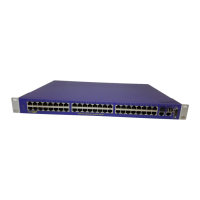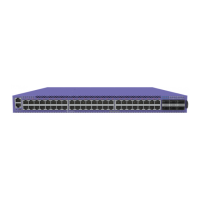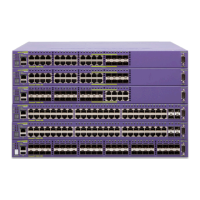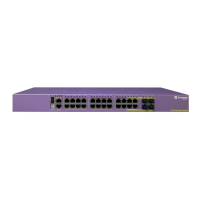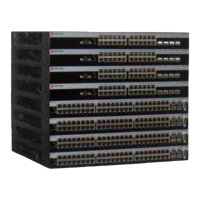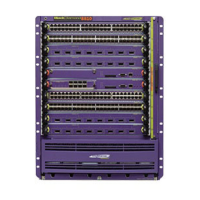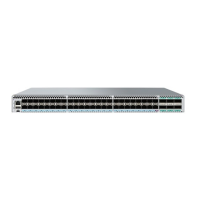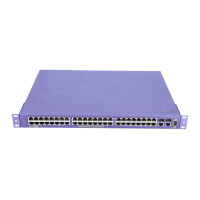
Do you have a question about the Extreme Networks 200 Series and is the answer not in the manual?
| Brand | Extreme Networks |
|---|---|
| Model | 200 Series |
| Category | Switch |
| Language | English |
Describes the purpose, scope, and intended audience of the installation and user guide.
Lists the key software features supported by the Summit 200 series switches.
Details the physical characteristics and components of the Summit 200-24 switch model.
Details the physical characteristics and components of the Summit 200-48 switch model.
Provides information on supported Mini-GBIC types and their specifications.
Guidance on selecting an appropriate and accessible location for switch installation.
Step-by-step instructions for physically installing the switch into a rack or setting it up.
Safety precautions and procedures for installing or replacing Mini-GBIC modules.
Instructions for connecting a terminal or workstation to the switch's console port for management.
Procedure for connecting power and turning on the switch.
Steps for initial login and basic configuration after powering on the switch.
Lists the key software features supported by the Summit 200 series switches.
Explains the concept and benefits of Virtual LANs for network segmentation and management.
Details the Spanning Tree Protocol for network fault tolerance and loop prevention.
Information on enabling software features using license keys for different functionality levels.
Explains the general rules and steps for entering commands via the command-line interface.
Lists and describes frequently used commands for managing the switch's basic functions.
Details how to set up user and administrator access levels for switch management.
Describes tools like Ping and Traceroute for verifying network connectivity.
Instructions for accessing and managing the switch via its console port.
Procedures for remotely managing the switch using the Telnet protocol.
Steps to enable and use SSH2 for secure remote command-line access to the switch.
Information on configuring and using SNMP for network management of the switch.
Describes methods for authenticating users, including RADIUS and TACACS+.
Details the network login feature for controlling access based on user authentication.
Instructions on how to enable or disable individual switch ports or ports within a VLAN.
Guides on manually setting port speed and duplex modes, or enabling autonegotiation.
Explains how to configure load sharing to increase bandwidth and network resiliency.
Details on configuring port mirroring for traffic analysis and monitoring.
Explains the concept of VLANs, their benefits, and how they segment networks.
Describes different methods for creating VLANs, including port-based and tagged VLANs.
Step-by-step guide on creating, naming, and configuring VLANs on the switch.
Details how to map physical ports to VLANs based on learned MAC addresses.
Explains the function and contents of the Forwarding Database (FDB) table.
Describes the different types of entries stored in the FDB, such as dynamic and permanent.
Provides commands and procedures for adding, deleting, and managing FDB entries.
Introduces access policies used for security, QoS, and traffic forwarding decisions.
Details how to create and use Access Control Lists for packet filtering and forwarding.
Explains how to configure rate limits to constrain traffic to predefined rates.
Describes how to control routing protocol advertisement and recognition using access policies.
Explains the concept of Network Address Translation (NAT) and its function.
Steps to configure VLANs as inside or outside for NAT operation.
Describes the four modes for assigning outside IP addresses and Layer 4 ports in NAT.
Provides instructions and commands for creating NAT translation rules.
Explains the Ethernet Automatic Protection Switching (EAPS) protocol for fast protection switching.
Details the commands used for configuring and monitoring EAPS domains and nodes.
Procedures for creating and deleting EAPS domains for ring protection.
Instructions on how to view the status and configuration of EAPS domains.
Explains policy-based QoS for specifying service levels for different traffic types.
Steps for applying QoS profiles to specific ports or VLANs for traffic management.
Details how traffic is classified and grouped for QoS policy application.
Using the QoS monitor to verify configuration and assess application performance.
Overview of the switch's status monitoring facility for performance analysis.
Provides detailed statistics for each port, including packet and byte counts.
Information on reviewing Ethernet link errors and port error types.
Details on configuring and managing system event logs, including local and remote logging.
Explains the Spanning Tree Protocol (STP) for network fault tolerance and loop prevention.
Guidance on configuring Spanning Tree Domains (STPDs) and their effect on VLAN traffic.
Step-by-step instructions for creating, enabling, and configuring STP domains and ports.
Procedures for disabling STP on the switch or resetting STP settings to defaults.
Introduces IP unicast routing and its role in network traffic exchange between routers.
Explains how VLANs with IP addresses function as router interfaces for IP traffic.
Describes how the switch's IP routing table is populated dynamically and statically.
Details the Proxy ARP functionality for responding to ARP requests on behalf of devices.
Introduces the two interior gateway protocols supported: RIP and OSPF.
Compares RIP and OSPF, highlighting their fundamental differences and advantages.
Provides details on the Routing Information Protocol (RIP), its operation, and limitations.
Explains the OSPF link-state routing protocol, its database, and operational aspects.
Introduces IP multicast routing and its core functions for group communication.
Steps for configuring Protocol Independent Multicast-Sparse Mode (PIM-SM).
Explains the Internet Group Management Protocol (IGMP) for multicast group membership.
Instructions for configuring IGMP and IGMP snooping for efficient multicast traffic handling.
Explains the concept of stacking multiple switches into a single logical unit.
Detailed steps for setting up a stack, including backup configuration and master enablement.
Procedures for recovering a stack configuration after issues like member failures.
Instructions on adding or removing members from a stack configuration.
Introduces ExtremeWare Vista as a web-based management interface for the switch.
Steps to access the ExtremeWare Vista interface via a web browser.
Explains how to navigate the graphical interface, including menus and controls.
Guides on configuring various switch features, including IP forwarding, OSPF, and Ports.
Describes how to access and interpret various statistical reports available in the GUI.
Information on finding help, downloading software, and contacting technical support.
Critical safety warnings and precautions for installing and operating the switch.
Guidelines for safe power connection, grounding, and handling of the power cord.
Detailed technical specifications for the Summit 200-24 switch model.
Detailed technical specifications for the Summit 200-48 switch model.
Procedure for downloading and installing new software images onto the switch.
Instructions for rebooting the switch, including scheduled and immediate reboots.
Guidance on saving the current switch configuration to nonvolatile storage.
Steps to upload the current switch configuration to a TFTP server for backup or analysis.
Troubleshooting common issues based on the status of the switch's LEDs.
Guidance on troubleshooting issues related to accessing and using the CLI.
Steps to resolve issues when a user cannot log into the switch due to forgotten credentials.
Troubleshooting common port configuration problems, such as link lights and errors.
